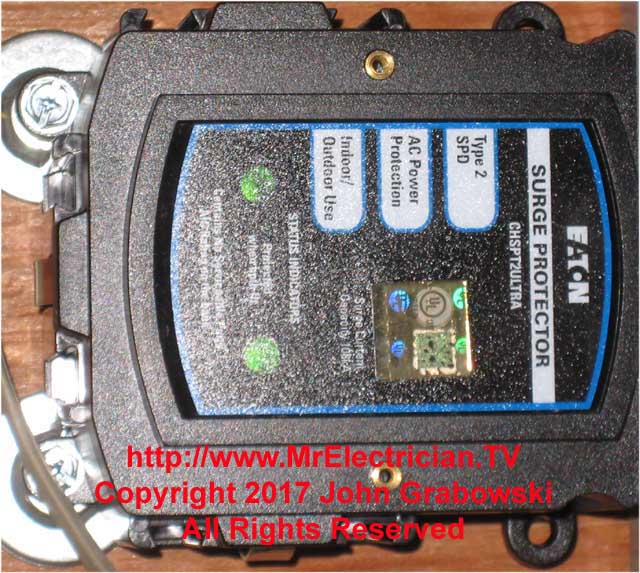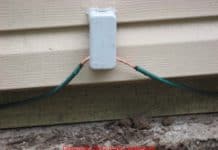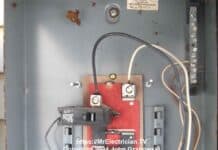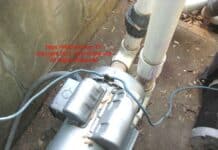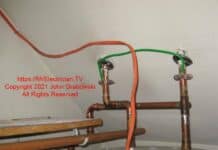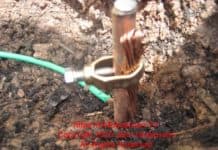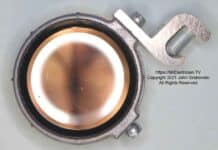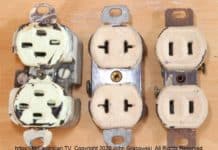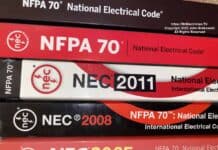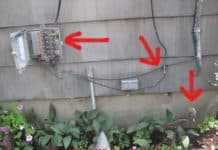Dear Mr. Electrician: What are the best whole house surge protectors to protect my home and RV from lightning, and how do I install them?
NOTE: Some text links below go to applicable surge protection products on Amazon and EMP Shield. As an Amazon Associate, I earn from qualifying purchases. Using my links helps to keep this website FREE.
Answer: The best whole-house surge protectors protect your home, appliances, and RV from lightning strikes, power surges, solar flares, and electromagnetic pulses.
Table of Contents:
- TYPES OF SURGE PROTECTORS
- INSTALLATION OF SURGE PROTECTION DEVICES
- TYPES OF SURGE PROTECTION DEVICE INSTALLATIONS
- EARTH GROUNDING LIGHTNING PROTECTION
Methods to install whole-house surge protectors vary slightly between devices and the type of main electrical panel in your home. However, installing a surge protector on your main electrical panel or RV is relatively easy compared to other electrical wiring tasks.
The total cost of installing a home surge protector will vary according to the cost of the surge protection device, the type of installation and location, and the electrical contractor labor rates in your area.
In addition, there will be fees for the electrical permit, electrical inspection, and possibly for power company services that may be required with the surge protector installation.
It is best to get estimates from several licensed electrical contractors in your area to make an informed decision. Some may be able to give you a ballpark estimate over the phone.
Installation of home surge protectors can be hazardous because of the live electrical components you have to work around. Use insulated tools and wear appropriate personal protection equipment.
Finding the best surge protectors to protect your home or RV from lightning will involve looking at the various specifications of many surge protection devices.
In addition to lightning and surge protection, consider a surge protection device (SPD) that offers protection from Solar Flares and Electromagnetic Pulses, which can also harm your home or RV’s electrical system.
Do some homework before making a surge protector purchase. Read reviews from other purchasers, compare the product ratings, and check the price ranges for your budget.
Surge protectors are covered by article 242, “Overvoltage Protection,” in the 2023 National Electrical Code. Other articles may apply according to the type of device and the installation. Article 230.67 requires a surge protection device for all electrical services supplying power to dwelling units.
Read the manufacturer’s installation instructions before purchasing. Many installation instructions are available online. The home or RV surge protector manufacturer’s installation instructions must be strictly adhered to for the best performance of the SPD and to pass inspection.
TYPES OF SURGE PROTECTORS
A type 1 home surge protection device is rated for the LINE side of an electrical service before the main disconnect. It is usually installed without a means of disconnection if it is before the main panel disconnect switch or the main breaker. The power company would most likely install this type.
Some type 1 surge protection devices can be installed on the LOAD side of the main breaker. Click here to see an example of a type 1 whole home surge protection device by Eaton.
A type 2 surge protection device is rated for the LOAD side of an electrical service after the main disconnect. This would typically be installed inside or attached to your main electrical panel.
A type 2 SPD can be shut off by the main breaker or a separate circuit breaker dedicated to the protector. Siemens has whole home surge protection devices that plug into a Siemens main circuit breaker panel like a QP circuit breaker.
A type 3 surge protection device is typically the point-of-use plug-in modules, power strips, and surge protector electrical receptacle outlets. They must be at least 30 feet or 10 meters from the main electrical service, as measured by the wiring distance. If less than 30 feet, they should also be rated for type 2.
Type 4 surge protectors are for equipment manufacturers to install on or inside their distributed appliances and machines.
You will need a type 1 or 2 whole-house surge protector with a high amperage rating for lightning protection. Only one percent of lightning strikes are as much 130,000 amps. You can probably get by with a 60,000 to 100,000 (60ka – 100ka) amp range device. The location of your home should be a consideration, as a house on the top of a mountain will be more prone to lightning strikes than one in a valley.
A lightning strike can occur at a power company pole down the street and affect your home. Lightning can hit the cable company wires and affect your home. Even a home satellite dish can attract a lightning strike. If lightning is not a concern, you can use a lower ka rating.
You will need an SPD with an operating voltage of 120/240 volts single phase for your home. It must have protection for line-to-neutral (L-N), line-to-ground (L-G), and neutral-to-ground (N-G). A bonus would be line-to-line (L-L) protection.
Clamping voltage, also called let through voltage or the Voltage Protection Rating (VPR), is the voltage a surge protector permits to pass through to the attached load. The clamping voltage should be over 169 volts, but 600 volts or less, maximum. The clamping voltage determines when the overvoltage from a surge is diverted to earth ground.
Underwriters Laboratories (UL) suggests three levels of protection for a 120 V AC system, and it is at 330 V, 400 V, and 500 V voltage levels. The standard clamping voltage for a 120V AC system is 330 V.
For a 120/240-volt installation, the VPR is higher. The clamping voltage is 600 volts for L-N and 1000 volts for L-L.
Do not be misled by joules ratings. Although it is a valid electrical term and unit of electrical energy measurement, it is not essential when considering whole-house surge protector specifications.
Most surge protection devices have indicator lights to tell you they are still working. Some, such as Siemens, have audible alerts as well. This is important because surge protectors do not live forever. Their working life is limited based on the number of surges they handle.
Though you may not notice, mini-surges occur in your home, from motors in appliances starting to power company fluctuations from switching sources or equipment. They all contribute to the wearing down of the surge protector’s internal components. The mini-surges also affect the electronics in your home, such as TVs, computers, and the same appliances that cause the surges. Hence the need for an SPD.
INSTALLATION OF SURGE PROTECTION DEVICES
The town’s electrical inspector in my area must inspect surge protectors installed in a main electrical panel. An electrical permit must be applied for at the building department. I submit a copy of the surge protector installation instructions with the permit application.
Suppose it is a complicated surge protector installation, or there are unusual circumstances. In that case, I will also submit a typed, one-page “Scope of Work” briefly explaining the planned SPD installation and the materials used.
It is better to find out beforehand if an inspector approves the installation rather than after the work is complete.
Safety is paramount when working with electricity, and you should take precautions. Do not wear jewelry, including watches and rings. Tie back long hair, use insulated tools, and cover exposed bus bars. Please read my post on safety when working around your home for more tips.
Shutting off the main circuit breaker will help, but I am sometimes reluctant to do that on older electrical panels because there is a possibility that the main circuit breaker will not turn on again.
Also, when the main circuit breaker is off, it does not always mean no electricity flows in the panel. In rare circumstances, a stray current could be on the neutral conductor. So with everything off, you should still treat it as being live.
I mostly encounter challenges finding enough space in the circuit breaker panel and the area around it to install the surge protection device. It is particularly tricky when the circuit breaker panel is recessed inside a wall.
For a recessed main electrical panel in the garage, a hole could be cut in the wall below or above the main electrical panel, depending on which end has the least number of wires.
Sometimes in those circumstances, I would install a metal access panel due to the fire rating of the garage wall. Other times I would use a surge protection device designed for recessed mounting. You cannot hide surge protection devices inside a wall where they will be inaccessible.
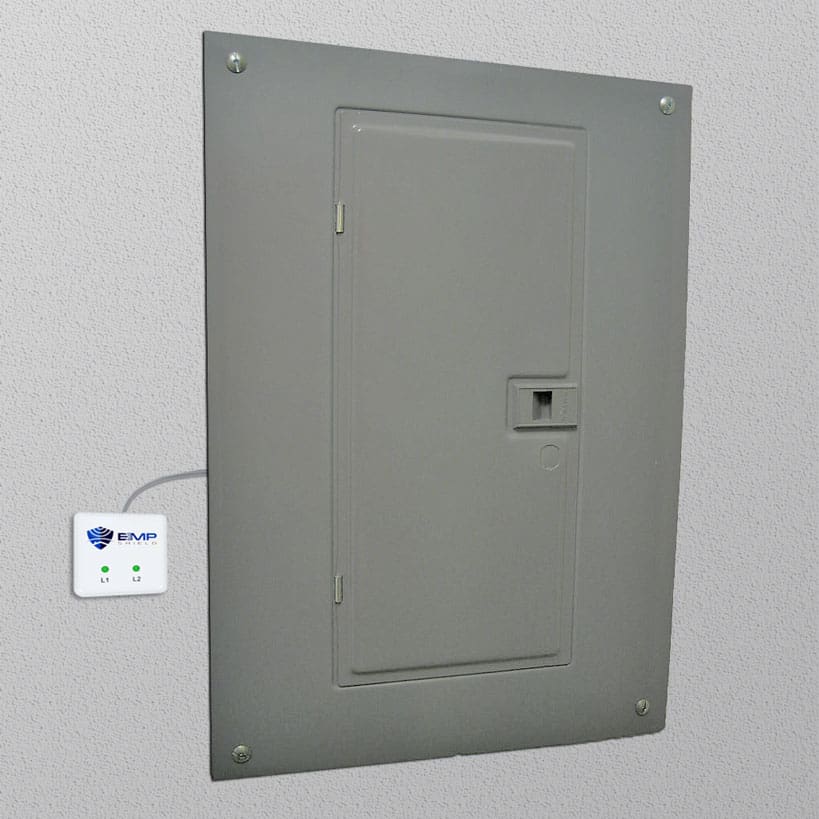
The surge protection device above features a small status indicator display outside the panel. Click here for details. See the video down below for installation tips. UL 1449 – Type 2 SURGE SUPPRESSION – Compliant
Many brands require their surge protection device to be connected to a dedicated two-pole circuit breaker. However, I often find no available circuit breaker spaces, or there is no two spaces side by side for an additional two-pole circuit breaker.
If there are no spaces side by side, I will move some of the existing circuit breakers around until I make room for a two-pole breaker.
Existing multi-wire circuits must have their breakers side by side and should be changed to two-pole circuit breakers or have approved handle ties installed while moving breakers around. See Article 210.4(B). Of course, everything moved has to be re-labeled on the panel cover.
If the circuit breaker panel is approved for thin-size or twin circuit breakers, I will install some to create additional spaces.
If there are no spare spaces, I look to see if every circuit breaker is in use and if I can double up some circuits onto existing breakers to free up two slots. This must be done with some thought as I don’t want to cause a circuit breaker to overload and, consequently, trip off as the homeowner uses power.
I also do not want to cause any electrical code violations by doubling up circuits required to be separate such as the kitchen or laundry.
Some circuit breaker manufacturers have a combination circuit breaker and surge protector, which supplies whole-house surge protection while not eliminating two circuit breakers. Check with your circuit breaker panel manufacturer for what is approved to be installed in your panel.
Surge protection devices are available for your car, home, antenna, recreational vehicle, and solar panels.
One particular item that I like is the surge protector made for circuit breaker panels recessed in a wall. Many condominiums, apartments, finished basements, and residential garages have circuit breakers in a recessed main electrical panel. It is a challenge to fit a regular surge protector outside them.
The EMP Shield is an electromagnetic pulse, Solar Flare, and lightning protection system designed to exceed the requirements of MIL-STD-188-125-1 for shunting over-voltage spikes. See their surge protection devices here.
TYPES OF SURGE PROTECTION DEVICE INSTALLATIONS
Some whole-house Surge Protection Devices connect to a circuit breaker. In contrast, others are designed to connect directly to the main terminals in your electrical panel without any circuit breaker protection or disconnect.
Some surge protectors plug directly onto the bus bar inside an electrical panel in the same location a circuit breaker plugs onto. I prefer a surge protector installation that can be disconnected for replacement or servicing if necessary.
Plug-in surge protector modules are available to protect one electrical appliance or component. Surge protection power strips allow several electrical items to be plugged in and protected.
Not all power strips have built-in surge protection. It is essential to read the labeling on these things. Buying only something with a UL label or other testing laboratory approval is best.
In addition, surge protection electrical receptacle outlets replace regular receptacle outlets. These are nice because they are in the wall, so you don’t have an additional corded device on the floor.
Reading and following the surge protection device manufacturer’s installation instructions is essential. The electrical inspector will follow what the manufacturer says.
Usually, the wire from the surge protector to the circuit breaker must be as short as possible. Also, the required circuit breakers tend to have a higher ampere rating than typically used on that size wire.
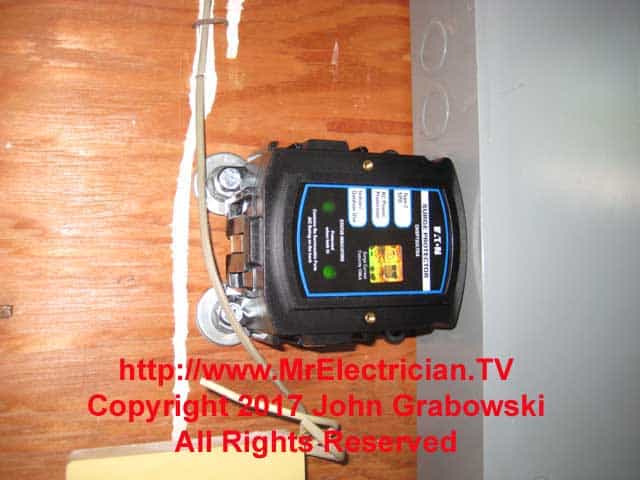
In the photo above, I put 3/8″ hex nuts under the mounting tabs of the surge protector to make it line up better with the existing 1/2″ knockout in the circuit breaker panel.
Sheet metal screws were used to attach it to the plywood backboard. Fender washers between the nuts and the plywood prevented the nuts from being pulled into the wood when I tightened the sheet metal screws.
EARTH GROUNDING LIGHTNING PROTECTION
Protecting your computer, appliances, and other home electronics from lightning is not as simple as installing a surge protector. When a surge protector limits the high voltage from a lightning strike, it will need the means to dissipate the excess current. The surge protector’s lightning current would automatically be diverted to earth in a well-grounded home.
The same is true for a plug-in surge protector power strip. The plug-in receptacle ground is connected to the grounding electrode system for the entire house and will only be as effective as the entire grounding system.
The home’s metal water service pipe, ground rods, well casing, and other metal pipes can be part of the grounding electrode system.
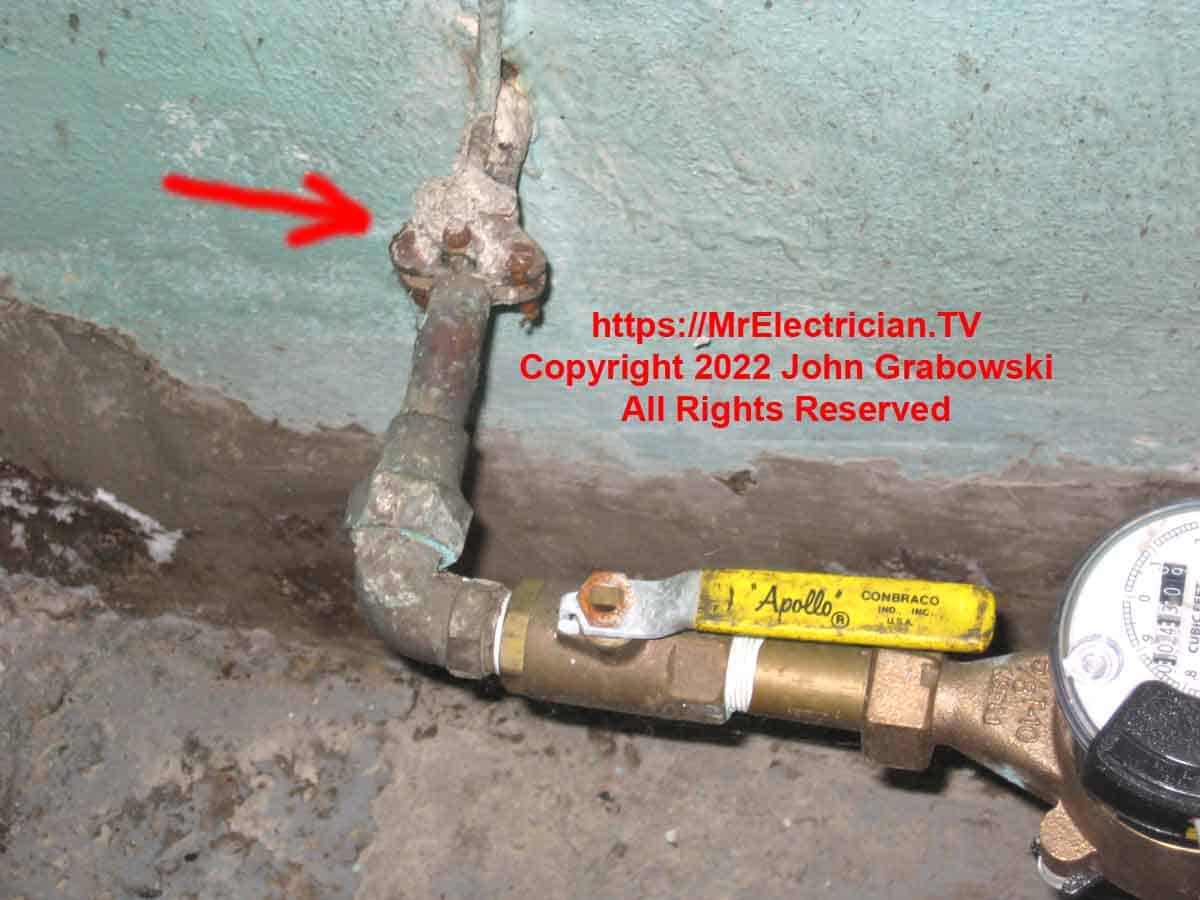
In an older home, a weak link in the grounding electrode system due to a loose or non-existent connection or corrosion of a component may cause the surge protector to be ineffective or, in some cases, hazardous because it cannot dissipate the excess voltage.
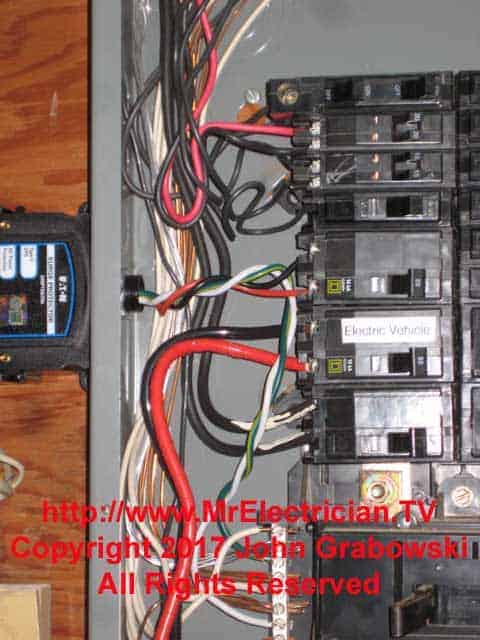
In the photo above, the manufacturer of the whole house protector specified, in the instructions, that the wires be twisted together and that the surge protector is to be connected to a two-pole 50 amp circuit breaker.
The instructions also said to keep the wires as short and direct to the circuit breaker as possible. I was lucky to have an open breaker slot and a 1/2″ knockout nearby.
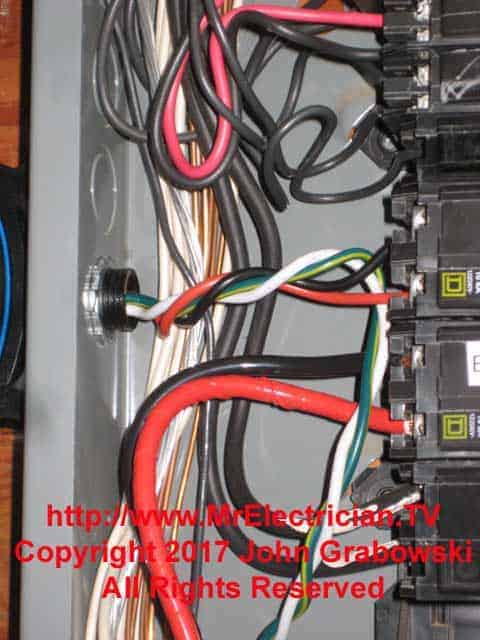
Before purchasing a surge protector, you should examine the main grounding electrode (Usually a water pipe or a ground rod or both) and the grounding electrode conductor connected to your electrical service.
Lightning will usually follow the most direct path of least resistance to Earth, and you would prefer that it does not detour through any of your electronic equipment or appliances and cause damage.
An effective grounding system with surge protection will enhance the electrical safety of your computer equipment and all electronic devices such as TVs, local network components, stereo amplifiers and receivers, microwave ovens, satellite dishes, appliances, and virtually anything else that is electronically or microprocessor controlled.
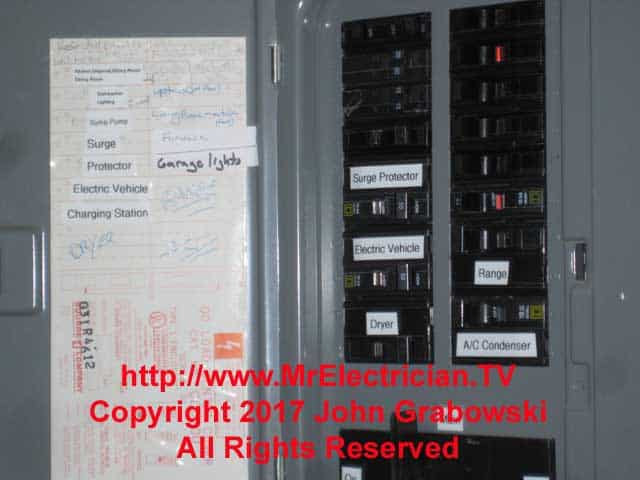
Some suggested reading in the “National Electrical Code” are Article 250, Grounding & Bonding, and Article 242, Overvoltage Protection.
For information about protecting your home against lightning strikes, you should read NFPA 780 Standard for the Installation of Lightning Protection Systems.
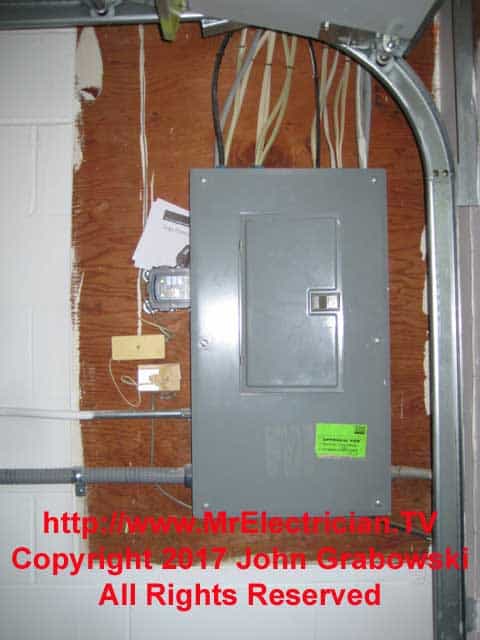
From the video above, whole house surge protectors are easy to install if you are comfortable working around live electricity. Do not do this yourself if you have never worked inside an electrical panel. It is just too hazardous for a beginner.
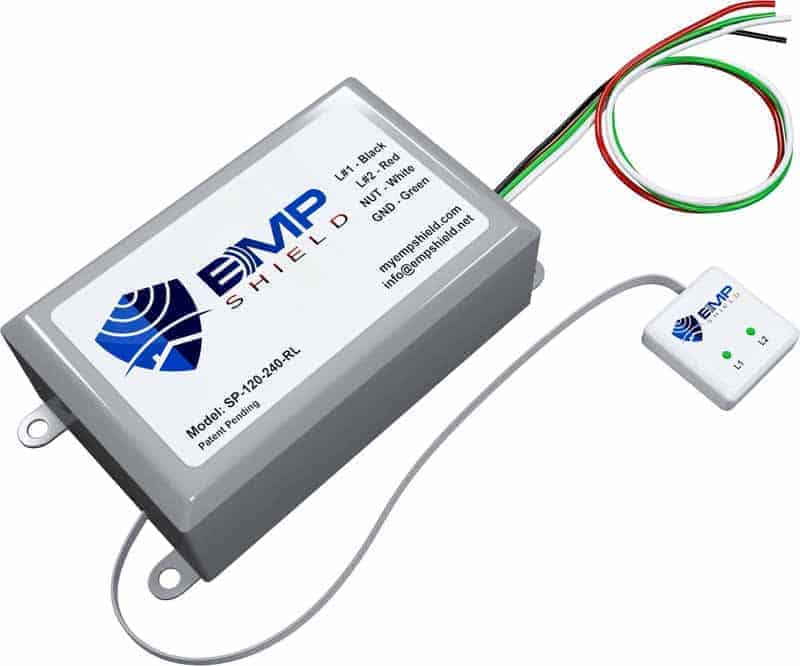
Leviton manufactures surge protection devices designed to be recessed in a wall.
An excellent post is about how I grounded and bonded an older home due to the homeowner’s concern about lightning damage.
Click here to see all of my Grounding and Bonding articles.
This Old House has a short video about installing surge protectors.
Click here to see details about a ground rod installation.
An Intersystem Bonding Termination, as required by articles 250.94, 545.27, and 770.100(B) in the National Electrical Code, makes it easier for other utilities to connect to your grounding electrode system.
Visit my Link Tree for links to my YouTube videos, social media, electrical supplies, merchandise, and more free electrical wiring information.
